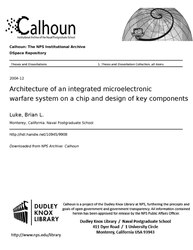File:Architecture of an integrated microelectronic warfare system on a chip and design of key components (IA architectureofni109459908).pdf

Original file (1,275 × 1,650 pixels, file size: 11.9 MB, MIME type: application/pdf, 323 pages)
Captions
Captions
Summary[edit]
| Architecture of an integrated microelectronic warfare system on a chip and design of key components
( |
||
|---|---|---|
| Author |
Luke, Brian L. |
|
| Title |
Architecture of an integrated microelectronic warfare system on a chip and design of key components |
|
| Publisher |
Monterey, California. Naval Postgraduate School |
|
| Description |
This dissertation investigates a mixed-signal, electronic warfare (EW) system-on-a-chip (SoC) design capable of synthesizing false radar returns in response to imaging radar interrogations that, when integrated into the range-Doppler processing, form an image of a false target. Detailed designs for the EW SoC components including the false target digital image synthesizer (DIS) and a novel analog to digital converter (ADC) are provided in this research. Alternative DIS architectures are presented that reduce circuit die area and power dissipation. This research also describes the theory, design, implementation, simulation, and testing of a proof-of-concept application-specific integrated circuit (ASIC) providing automatic counterflow-clock pipeline skew control for the DIS. High performance ADCs are key components of mixed-signal SoCs. Design and simulation results for an 8-bit 1 GS/s robust symmetric number system (RSNS) folding ADC are presented. The gray-code properties of the RSNS make it desirable for error control and low-power ADC implementations. A complete mathematical description of the N-modulus RSNS redundancies is discovered, which results in closed-form expressions for the longest sequence of unique RSNS vectors for moduli of the form m - 1, m, and m +1, as well as an efficient search algorithm for N-modulus systems at least six orders of magnitude faster than previously published results. Lastly, an N-modulus RSNS-to-binary converter design procedure and a circuit design for an 8-bit, 4-modulus 1 GS/s RSNS-to-binary converter are presented. Subjects: Electronics in military engineering.; Folding ADC; gray-code properties; dynamic range; residue number system; robust sym-metric number system; inverse synthetic aperture radar; electronic warfare; system-on-a-chip; wideband imaging radar; digital image synthesis; radar countermeasures; anti-ship ca-pable missile; counterflow clock pipeline; automatic clock skew control |
|
| Language | English | |
| Publication date | December 2004 | |
| Current location |
IA Collections: navalpostgraduateschoollibrary; fedlink |
|
| Accession number |
architectureofni109459908 |
|
| Source | ||
| Permission (Reusing this file) |
Upon consultation with NPS faculty, the School has determined that this dissertation may be released to the public and that its distribution is unlimited, effective January 25, 2011. | |
Licensing[edit]
| Public domainPublic domainfalsefalse |
This file is a work of a sailor or employee of the U.S. Navy, taken or made as part of that person's official duties. As a work of the U.S. federal government, it is in the public domain in the United States.
|
 | |
| This file has been identified as being free of known restrictions under copyright law, including all related and neighboring rights. | ||
https://creativecommons.org/publicdomain/mark/1.0/PDMCreative Commons Public Domain Mark 1.0falsefalse
File history
Click on a date/time to view the file as it appeared at that time.
| Date/Time | Thumbnail | Dimensions | User | Comment | |
|---|---|---|---|---|---|
| current | 18:06, 14 July 2020 |  | 1,275 × 1,650, 323 pages (11.9 MB) | Fæ (talk | contribs) | FEDLINK - United States Federal Collection architectureofni109459908 (User talk:Fæ/IA books#Fork8) (batch 1993-2020 #8123) |
You cannot overwrite this file.
File usage on Commons
The following page uses this file:
Metadata
This file contains additional information such as Exif metadata which may have been added by the digital camera, scanner, or software program used to create or digitize it. If the file has been modified from its original state, some details such as the timestamp may not fully reflect those of the original file. The timestamp is only as accurate as the clock in the camera, and it may be completely wrong.
| Short title | Architecture of an integrated microelectronic warfare system on a chip and design of key components |
|---|---|
| Author | Luke, Brian L. |
| Software used | Luke, Brian L. |
| Conversion program | Adobe Acrobat 9.41 Paper Capture Plug-in |
| Encrypted | no |
| Page size |
|
| Version of PDF format | 1.4 |

